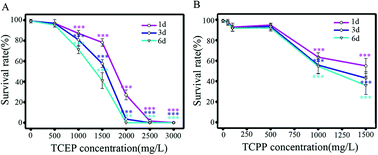Tris(2-chloroethyl) phosphate (TCEP) and tris(2-chloropropyl) phosphate (TCPP) induce locomotor deficits and dopaminergic degeneration in Caenorhabditis elegans†
Abstract
Organophosphate flame retardants (PFRs) are a new class of flame retardants. The health risks of PFRs have received attention recently. However, little is known about the potential toxicity of PFRs on the nervous system. Herein, we evaluated the neurotoxic effects of two typical PFRs, tris(2-chloroethyl) phosphate (TCEP) and tris(2-chloropropyl) phosphate (TCPP), using Caenorhabditis elegans. Median lethal concentrations of chronic exposure (3 d) were 1578 and 857 mg L−1 for TCEP and TCPP, respectively. The sublethal dose of TCEP or TCPP significantly inhibited the body length and reduced the lifespans of nematodes. 500 mg L−1 and above of TCEP/TCPP led to a significant decline in the locomotor frequency of body bending and head thrashing. Furthermore, their exposure reduced the crawling speed and the frequency of bending oscillation of nematodes. This indicates that TCEP/TCPP induces locomotor deficits, along with Parkinsonian-like movement impairment including bradykinesia and hypokinesia. Using transgenic worms, we found that TCEP/TCPP could induce down-expression of Pdat-1 and resulted in the degeneration of dopaminergic neurons, especially PDE neurons. Moreover, TCEP/TCPP induced over-expression of unc-54, which indicates the aggregation of α-synuclein in the process of degeneration. These findings suggest the neurotoxicity risks of organophosphorus flame retardants, which are associated with the locomotor deficits and dopaminergic degeneration.

- This article is part of the themed collection: Toxicology Research 2017 Most Downloaded Articles

 Please wait while we load your content...
Please wait while we load your content...